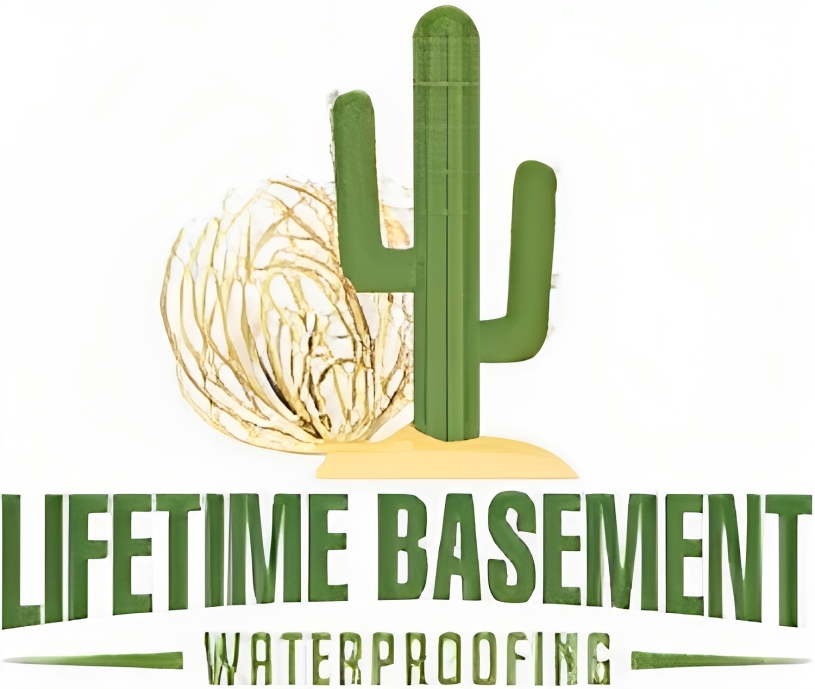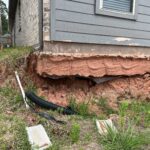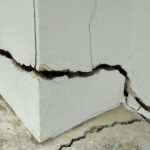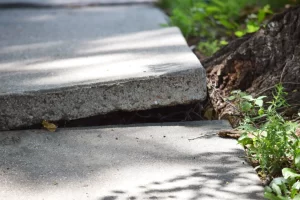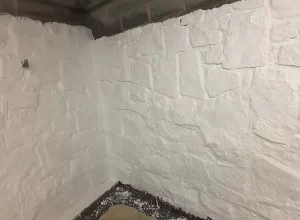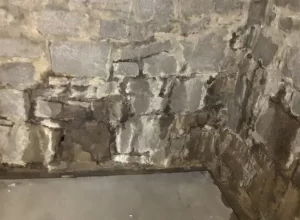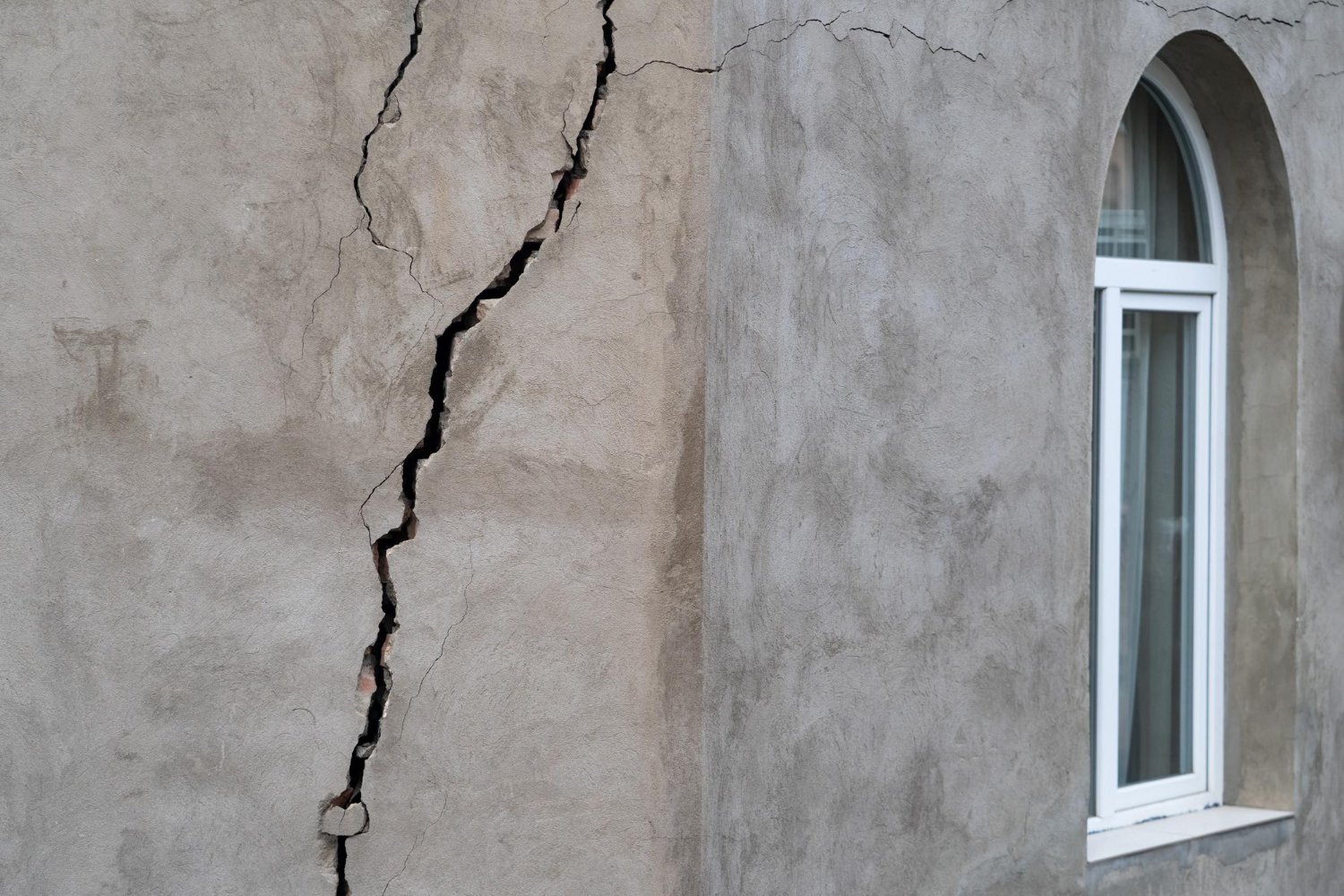
If you see cracks in your walls or ceilings, it might be a sign of water damage or foundation cracks that need your attention. These issues can lead to further damage if not addressed promptly, potentially affecting the structural integrity of your home. Be on the lookout for discoloration, musty odors, and standing water as additional signs that could indicate underlying problems requiring immediate action. Understanding these common indicators can help you safeguard your property and address any concerns efficiently.
Key Takeaways
- Discoloration like yellow/brown stains may indicate water damage or foundation cracks.
- Musty odors signal water damage or foundation issues, leading to mold growth.
- Cracks in walls/floors can result from foundation settling or water damage.
- Warped/sagging floors may be due to moisture or foundation settlement.
- Standing water indoors suggests water damage or foundation issues, requiring prompt attention.
Discoloration on Walls and Ceilings
If you notice discoloration on your walls and ceilings, it may indicate either water damage or foundation cracks. These signs are important to address promptly as they can lead to more severe issues if left unchecked.
Water damage often manifests as yellow or brown stains on walls and ceilings. These stains can spread over time and may be accompanied by peeling paint or wallpaper. In more severe cases, you might notice bulging or warping of the walls. If you suspect water damage, it’s vital to identify and fix the source of the moisture to prevent further harm to your home’s structure.
On the other hand, foundation cracks can also cause discoloration in your living spaces. Cracks in the foundation can allow moisture to seep into the walls, leading to stains and discoloration. Additionally, foundation cracks may be accompanied by other signs such as uneven floors or doors that no longer close properly. Addressing foundation issues promptly is essential to prevent structural damage to your home.
Musty or Moldy Odors
You may notice a musty or moldy odor in your home, which can be a sign of either water damage or foundation issues. These unpleasant odors are often a result of moisture buildup in hidden areas of your home. If you detect a musty smell, it’s important to investigate the source promptly to determine whether it indicates water damage or foundation problems.
Musty odors associated with water damage are typically caused by mold or mildew growth due to excess moisture. Leaking pipes, roof leaks, or poor ventilation can create the perfect environment for mold to thrive. If left unchecked, water damage can lead to structural issues and health concerns for you and your family.
On the other hand, musty odors linked to foundation problems may indicate water seepage into your basement or crawl space. When foundations crack or shift, water can infiltrate these spaces, causing a damp environment that promotes mold growth. Addressing foundation issues promptly is vital to prevent further damage to your home’s structure.
Cracks in Walls or Floors
Cracks can develop in walls or floors as a potential indicator of underlying structural issues within a property. When you notice cracks in your walls, especially those that are diagonal or stair-step patterns, it could signal problems with the foundation. These cracks may be a result of the foundation settling unevenly or shifting, causing stress on the walls above. In some cases, you may also observe cracks in the corners of windows and doors, indicating potential foundation movement.
Similarly, cracks in the floors can also point towards structural concerns. Pay attention to any cracks in the concrete slab or basement floor, as these can be a sign of water damage or foundation issues. If you see widening cracks or notice them in conjunction with other symptoms like uneven floors, it’s important to address the problem promptly.
It’s essential to differentiate between minor cracks caused by normal settling and more severe cracks that indicate a larger problem. Regularly inspecting your walls and floors for any new or worsening cracks can help you catch issues early. If you suspect structural damage, consulting a professional for a thorough assessment is advisable to determine the best course of action for repairs.
Warped or Sagging Floors
Have you noticed any warping or sagging in your floors lately? Warped or sagging floors can be a clear indication of underlying issues that may be related to water damage or foundation problems. When your floors start to slope or feel uneven underfoot, it’s vital to investigate the root cause promptly.
Warped floors are often a result of moisture-related problems. Water can seep into the subflooring, causing it to swell and warp over time. This can happen due to leaks from plumbing fixtures, appliances, or even excessive humidity levels in your home. If left unchecked, this moisture can lead to more severe water damage issues and potentially compromise the structural integrity of your home.
Sagging floors, on the other hand, may be a sign of foundation settlement or damage. When the foundation of your home shifts or sinks, it can cause the floors above to sag or dip. This can occur due to poor soil compaction, inadequate foundation footings, or water-related issues that weaken the foundation over time.
If you notice any warping or sagging in your floors, it’s important to address the underlying problem promptly. Ignoring these issues can lead to more extensive damage and costly repairs down the line. Consider contacting a professional to assess the situation and recommend the appropriate course of action to restore the integrity of your floors and home.
Standing Water or Puddles
If you’ve noticed any standing water or puddles in your home, it could be a sign of potential water damage or foundation issues. Water shouldn’t accumulate indoors, so if you spot pools of water where they shouldn’t be, it’s vital to investigate the underlying cause promptly.
Standing water or puddles can indicate various problems. It might be due to a leaky pipe, poor drainage, or even a crack in your foundation. If the puddles appear near the walls, it could suggest a foundation issue allowing water to seep into your home. Additionally, standing water can lead to mold growth, which poses health risks and further deteriorates your home’s structure.
To determine the source of the standing water, check for any visible leaks in plumbing fixtures or pipes. Inspect your basement and crawl spaces for signs of water intrusion or dampness. Make sure that your gutters and downspouts are clear of debris and functioning correctly to prevent water from pooling around your foundation.
Addressing standing water promptly is important to prevent extensive water damage and potential foundation issues. If you’re unable to identify the source of the problem or if the standing water persists, consider consulting a professional to assess and address the situation effectively.
Misaligned Doors or Windows
When doors or windows become misaligned in your home, it may indicate underlying structural issues that need attention. Misaligned doors or windows can be a sign of potential foundation problems or shifting of the structure, which should be addressed promptly to prevent further damage.
Here are five key points to keep in mind when evaluating misaligned doors or windows:
- Difficulty Opening or Closing: If you notice that your doors or windows are suddenly harder to open or close, it could be a sign of misalignment due to foundation issues.
- Gaps Around the Frames: Visible gaps around the frames of doors or windows may indicate that the structure has shifted, causing misalignment.
- Uneven Window Sashes: Windows that no longer close evenly or have uneven gaps when closed could be a result of foundation movement.
- Visible Cracks in Walls: Misaligned doors or windows can sometimes cause stress on the surrounding walls, leading to visible cracks.
- Water Leakage: Misalignment can create gaps that allow water to seep in, potentially causing water damage and exacerbating the structural issues.
Keep an eye out for these signs to catch any underlying problems early and prevent further damage to your home.
Frequently Asked Questions
Can Water Damage Lead to Foundation Cracks in a Home?
Water damage can indeed lead to foundation cracks in a home. When excess moisture weakens the soil beneath your foundation, it can cause shifting and settling, which may result in cracks forming over time.
How Can I Differentiate Between Water Damage and Foundation Cracks in My Home?
To differentiate between water damage and foundation cracks in your home, inspect for water stains, mold, and musty odors signifying water damage. Foundation cracks often appear as vertical or diagonal lines on walls, floors, or ceilings. Consult a professional for accurate assessment.
Are There Any Long-Term Health Risks Associated With Musty or Moldy Odors in a Home?
If you notice musty or moldy odors in your home, there could be long-term health risks. Mold exposure may lead to respiratory issues, allergies, and other health problems. It’s important to address these odors promptly for a healthier living environment.
What Are Some Potential Causes of Warped or Sagging Floors That Are Not Related to Water Damage or Foundation Issues?
If you notice warped or sagging floors unrelated to water damage or foundation issues, potential causes might include poor installation, subfloor issues, or humidity changes. Check for these factors to address the problem effectively.
How Can Standing Water or Puddles in a Home Impact the Structural Integrity of a Building Over Time?
Standing water or puddles in your home can seep into walls, weaken foundations, and cause structural damage over time. Regularly check for and address any areas with water accumulation to maintain the building’s integrity.
Conclusion
Lifetime Basement Waterproofing has been Atlanta’s premier basement waterproofing company for over 30 years.
As a family-owned and operated company, we specialize in basement waterproofing and offer a range of expert services.
Our expertise includes crawlspace encapsulation, exterior foundation waterproofing, foundation crack repair, and designing drainage strategies for French drains.
When it comes to wet basement repair needs, you can trust Lifetime Basement Waterproofing to provide reliable and professional solutions.
